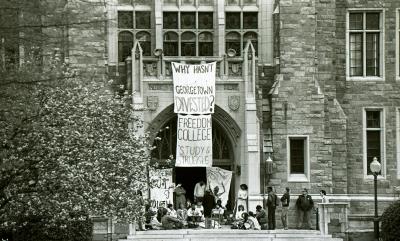In April 1986, the Georgetown University Student Coalition Against Racism (SCAR) and the Progressive Student Union (PSU) launched a series of protests regarding the University’s investment in American companies that profit from business in apartheid-era South Africa. At the time, Georgetown’s holding in these companies, an estimated $28.6 million, represented 16% of the University’s endowment.1
Student Protests
SCAR and PSU hosted candlelight vigils, drafted countless petitions, and staged a day-long apartheid simulation on campus. Sections of the campus were cordoned off: whites only and blacks only, and black students were given priority across campus in everything from the lines at Vital Vittles to classes. 2Then students formed “Freedom College,” a two week demonstration on the White Gravenor patio that took over the building’s entrance. On April 24, students built a shanty on Copley lawn as a symbolic expression of solidarity.
University and Police Response
Dean of Student Affairs John DeGioia immediately ordered the deconstruction and removal of the shanty. In a later press release, he commented, "I have a fiduciary responsibility to protect the members of this community, and it was in my judgment that if the shanty went up I would no longer be honoring that responsibility. "3When the students refused to listen to Dean DeGioia or the GUPS officers, the DC Metropolitan Police Department (MPD) responded to the scene and arrested thirty-five students. Twenty-nine students were charged with unlawful entry of White Gravenor because of their refusal to leave the entrance. DC MPD charged an additional six students with obstruction of public roads when they tried to stop police vehicles from leaving Healy Circle.4
Three days later, the Georgetown University Student Association (GUSA) joined a petition condemning the University’s action. The Student Activities Commission responded with a letter reprimanding the PSU for activities that violated the PSU’s charter as a University-recognized student organization. On May 14, for the first time in University history, the faculty called and held a general faculty meeting. Together, 110 faculty members passed a series of resolutions including a call for the University to drop all charges against the thirty-five protestors.
Shortly after, Dean DeGioia sent a letter to the U.S. District Attorney on the case writing, "It has never been the University's intent to take action of a punitive nature against the students beyond that required to regain control of the campus." 5The District Attorney dropped the charges, but the Georgetown adjudication board voted to uphold the school’s disciplinary action placing the protestors on disciplinary probation until May 1987.
Divestment and Legacy
That September, the University formally announced its plans to divest from the American companies that profit from South African apartheid.6 Perhaps equally important, the University also responded to the Apartheid protests by creating a committee to clarify student rights regarding civil dialogue, protesting, and demonstrations. For two and a half years, the committee worked through several proposals before publishing the final policy in January 1989. In the Speech and Expression policy, co-author Fr. James Walsh, S.J writes, “A university is many things, but central to its being is discourse, discussion, debate: the untrammeled expression of ideas and information.” 7Under the policy, any public meeting on campus required a reservation in advance, except for Red Square, which any student could use during the daytime “for the purpose of exchanging ideas” without prior arrangement. 8Importantly, students were permitted to gather and discuss any issue “as long as they reserve the space, pay associated costs, and abide by noise restraints.”9
- 1Cipollitti, Patricia. “Investing in Transparency: The Ethics of Georgetown’s Portfolio.” The Georgetown Voice. 20 Sept. 2012.
- 2Georgetown University (Washington, DC), Ye Domesday Booke, 1986, p.55.
- 3Id. at p.54.
- 4Haggerty, Tim. “Latest Protest Is Not the First for GU.” The Hoya. 12 Feb. 1999.
- 5Ye Domesday Booke, 1986, p.54.
- 6“Investing in Transparency: The Ethics of Georgetown’s Portfolio.”
- 7Jones, Connor. “The Limits on Free Expression: Red Tape and Red Square.” The Georgetown Voice. 11 April 2013.
- 8Id.
- 9Id.


